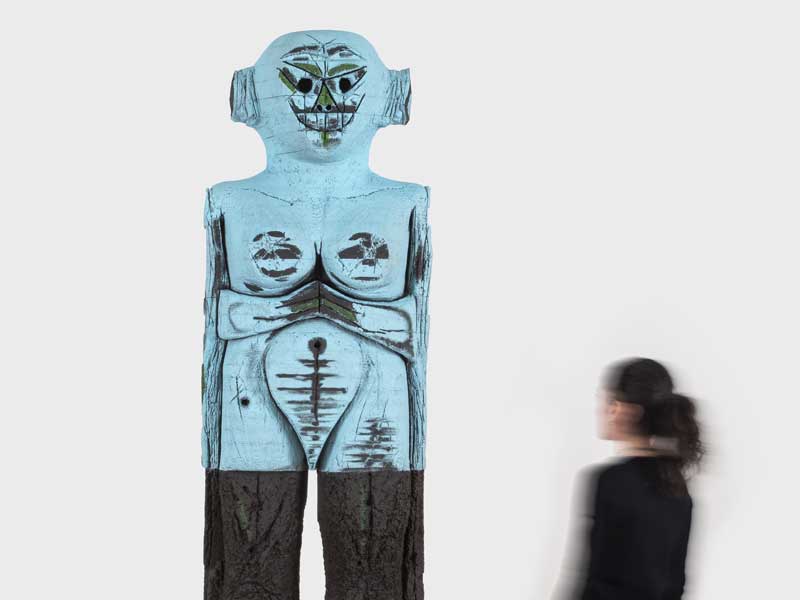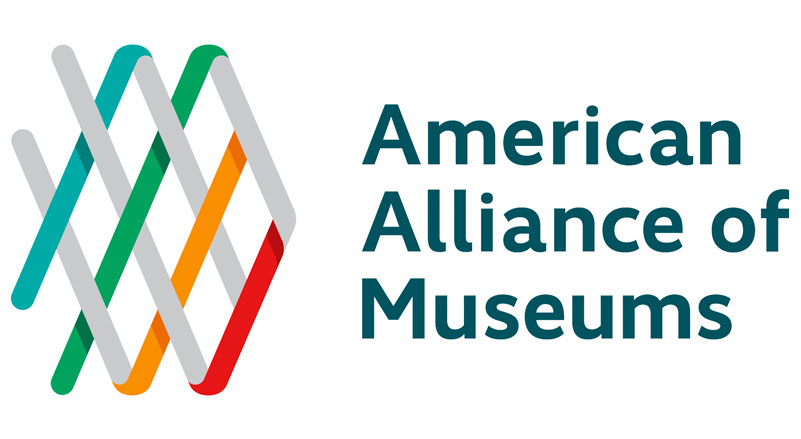
RELEASE DATE: MAR 16, 2023
The Weatherspoon Art Museum at UNC Greensboro announces the acquisition of a major sculpture, Receiver (2019), by renowned artist Huma Bhabha. This remarkable and timely addition to the museum’s collection of modern and contemporary art will prompt rich conversations concerning the issues it raises around communication, environmentalism, and popular culture, among others.
“Huma Bhabha’s Receiver is a work of magnificent literal and figurative proportions—we could not be more excited or grateful to welcome it into the Weatherspoon courtyard,” says Juliette Bianco, the museum’s Anne and Ben Cone Memorial Endowed Director. “Being open to receiving is a start for human cooperation. We hope that this sculpture, stepping into the Weatherspoon space with all of us, embodies that connectedness and becomes a marker of the museum experience.”
The museum staff invites the community to hear from the artist and celebrate the dedication of this monumental artwork in the Weatherspoon’s sculpture courtyard on April 14. The event is free and open to all.
Drawing equally from classical precedents such as ancient Egyptian and Greek sculpture and modern referents such as science fiction films, Huma Bhabha crafts enigmatic beings that engage our notions of humanity and our understanding of self and other. Bhabha’s figures greet us as mysterious time travelers, raising many questions. Is that grin gleeful or mischievous? Did this creature arrive here from the past or the future? Was it exhumed from an archeological dig or dropped down from a spaceship? Is it more human or divine, monster or alien?
In addition to these human involvements, Bhabha is also concerned with how we interact with the environment, and specifically the waste we produce and our inability to see the beauty and usefulness in the discarded. Countering these habits, she crafts her sculptures from found cork, Styrofoam, and other abandoned materials that she assembles, carves, and then casts in bronze. Receiver retains the textures of these materials, as well as additional marks added with paint—bits of red that suggest painted toenails and dabs of green and yellow that recall both graffiti and body art.
How one interprets these elements will depend on the personal and cultural contexts one brings to the encounter. When Receiver was installed at a busy intersection in Wakefield, England, in 2019, Bhabha said, “I like that it’s at a crossroads so it’s almost like a traveler, a receiver, with people driving, walking, stopping by.” The Weatherspoon Art Museum, as a meeting place for campus and community engagement at an institution for higher education, is another kind of crossroads that offers an equally tantalizing opportunity for contemplation. As Weatherspoon curator Emily Stamey notes, “The museum staff is excited to see how this artwork will spark engagement with faculty and students from across an array of disciplines—from anthropology to art history, English to environmental studies, media studies to history and religion.”
Born and raised in Karachi, Pakistan, and now based in Poughkeepsie, New York, artist Huma Bhabha moved to the United States in 1981 and received her BFA from the Rhode Island School of Design and her MFA from Columbia University. In 2018, Bhabha was selected to create a site-specific installation for the Metropolitan Museum of Art’s roof garden, and her monumental work there, titled We Come in Peace, addressed themes of colonialism, war, displacement, and memories of place. Bhabha’s art is represented in the collections of the Bronx Museum, New York (NY); Centres Georges Pompidou, Paris (FR); the Hammer Museum, Los Angeles (CA); the Hirshhorn Museum, Washington, D.C.; the Los Angeles County Museum of Art (CA); the Museum of Modern Art, New York (NY); the Metropolitan Museum of Art, New York (NY); the Sharjah Art Foundation (UAE); Tate, London (UK); the Whitney Museum of American Art, New York (NY); and the Yale University Art Gallery, New Haven (CT), among many others.
On Friday, April 14, at 4:30pm, Bhabha will talk about her work in the Margaret and Bill Benjamin Auditorium in the Weatherspoon Art Museum. A reception will follow in the sculpture courtyard from 5:30 to 7pm, with dedication remarks at 6pm.
Huma Bhabha’s Receiver comes to the Weatherspoon thanks in part to the generous support of the Tannenbaum-Sternberger Foundation in memory of long-time museum supporter Leah Louise B. Tannenbaum.
Image: Huma Bhabha, Receiver, 2019. Bronze, 98 3/4 x 18 x 25 in. Edition 3/4. Weatherspoon Art Museum. Purchase with funds from the Tannenbaum-Sternberger Foundation in memory of Leah Louise B. Tannenbaum, the Weatherspoon Art Museum Acquisition Endowment, the Weatherspoon Guild Acquisition Endowment, and by exchange. © Huma Bhabha, photo courtesy of the artist; David Zwirner, New York; and Salon 94, New York
About the Weatherspoon Art Museum
Mission
The Weatherspoon Art Museum at UNC Greensboro enriches the lives of diverse individuals and connects multiple communities, both on and off campus, by presenting, interpreting, and collecting modern and contemporary art. In recognizing its paramount role of public service, the Weatherspoon fosters an appreciation of the ability of art to positively impact lives.
History
The Weatherspoon Art Museum at UNC Greensboro was founded by Gregory Ivy in 1941 and is the earliest of any art facilities within the UNC system. The museum was founded as a resource for the campus, community, and region and its early leadership developed an emphasis—maintained to this day—on presenting and acquiring modern and contemporary works of art. A 1950 bequest from the renowned collection of Claribel and Etta Cone, which included prints and bronzes by Henri Matisse and other works on paper by American and European modernists, helped to establish the Weatherspoon’s permanent collection.
In 1989, the museum moved into its present location in The Anne and Benjamin Cone Building designed by the architectural firm Mitchell Giurgula. The museum has six galleries and a sculpture courtyard with over 17,000 square feet of exhibition space. The American Alliance of Museums accredited the Weatherspoon in 1995 and renewed its accreditation in 2005 and 2015.
Collections + Exhibitions
The permanent collection of the Weatherspoon Art Museum is considered to be one of the foremost of its kind in the Southeast. It represents all major art movements from the beginning of the 20th century to the present. Among the nearly 6,200 works in the collection are pieces by such prominent figures as Henry Ossawa Tanner, Edward Weston, Joseph Stella, David Smith, Jackson Pollock, Elizabeth Catlett, Louise Nevelson, Gordon Parks, Sol LeWitt, Robert Mangold, Cindy Sherman, Adrian Piper, Betye Saar, Amy Silman, Nick Cave, Jennifer Steinkamp, and Sanford Biggers. The museum regularly lends to major exhibitions nationally and internationally.
The Weatherspoon also is known for its dynamic exhibition program. Through a lively annual calendar of exhibitions and a multi-disciplinary educational program for audiences of all ages, the museum provides an opportunity for visitors to consider artistic, cultural, and social issues of our time—enriching the life of our university, community, and region.
UNC Greensboro
Located in North Carolina’s third largest city, UNC Greensboro is among the most diverse, learner-centered public research universities in the state, with nearly 18,000 students in eight colleges and schools pursuing more than 150 areas of undergraduate and over 200 areas of graduate study. UNCG continues to be recognized nationally for academic excellence, access, and affordability. UNCG is ranked No. 1 most affordable institution in North Carolina for net cost by the N.Y. Times and No. 1 in North Carolina for social mobility by The Wall Street Journal — helping first-generation and lower-income students find paths to prosperity. Designated an Innovation and Economic Prosperity University by the Association of Public and Land-grant Universities, UNCG is a community-engaged research institution with a portfolio of more than $67M in research and creative activity. The University’s 1,100 faculty and 1,700 staff help create an annual economic impact for the Piedmont Triad region in excess of $1B. For additional information, please visit uncg.edu and follow UNCG on Facebook, Twitter, and Instagram.
Weatherspoon Art Museum
UNC Greensboro
1005 Spring Garden Street
Greensboro, NC 27412, (336) 334-5770, weatherspoon@uncg.edu
For more information or press images, contact:
Loring Mortensen, (336) 256-1451, lamorten@uncg.edu


